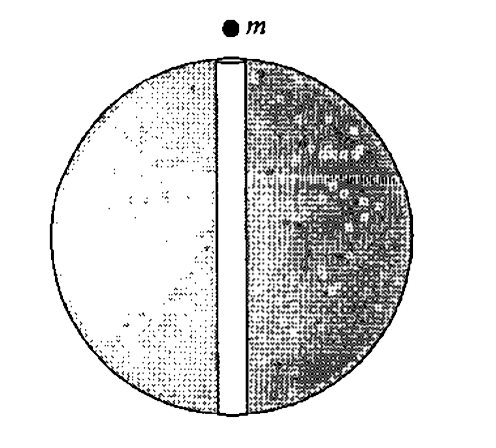A smooth tunnel is dug along the radius of earth that ends at centre. A ball is relrased from the surface of earth along tunnel. Caefficient of restitution for collision between soil at centre and ball is 0.5. Caculate the distance travelled by ball just second collision at center. Given mass of the earth is M and radius of the earth is R.
The correct Answer is:B, D
To solve the problem step by step, we will analyze the motion of the ball in the tunnel and the effects of the collision with the soil at the center of the Earth.
Step 1: Initial Conditions
The ball is released from the surface of the Earth (height = R) and falls towards the center of the Earth through the tunnel. Initially, the potential energy (PE) at the surface is given by:
PEi=−GMmR
where G is the gravitational constant, M is the mass of the Earth, m is the mass of the ball, and R is the radius of the Earth.
Step 2: Energy Conservation to Find Velocity at the Center
At the center of the Earth, the potential energy is:
PEf=−3GMm2R
Using conservation of energy, we equate the initial potential energy to the final potential energy plus kinetic energy (KE):
−GMmR=−3GMm2R+12mv2
Step 3: Solve for Velocity at the Center
Rearranging the equation gives:
12mv2=−GMmR+3GMm2R
This simplifies to:
12mv2=GMm2R
Dividing by m and multiplying by 2:
v2=GMR
Taking the square root:
v=√GMR
Step 4: Collision at the Center
Upon reaching the center, the ball collides with the soil. The coefficient of restitution e is given as 0.5. The velocity after the collision is:
v′=e⋅v=0.5⋅√GMR
Step 5: Motion After Collision
After the collision, the ball will move back towards the surface. The initial velocity for this upward motion is v′.
Step 6: Energy Conservation for Upward Motion
Using energy conservation again, we can find the height the ball reaches after the collision. The potential energy at the maximum height h is given by:
PE=−GMmR−h
Setting the initial kinetic energy equal to the potential energy at the maximum height:
12mv′2=−GMmR−h
Substituting v′:
12m(0.5⋅√GMR)2=−GMmR−h
This simplifies to:
12m⋅0.25GMR=−GMmR−h
Step 7: Solve for Maximum Height
Cancelling m and rearranging gives:
0.125GMR=GMR−h
Cross-multiplying and simplifying:
0.125(R−h)=R
This leads to:
0.125R−0.125h=R
Rearranging gives:
−0.125h=R−0.125R
−0.125h=0.875R
Thus:
h=−0.875R−0.125=7R
Step 8: Total Distance Travelled
The total distance travelled by the ball before the second collision is:
1. Distance to the center: R
2. Distance back up to height h: 7R
Thus, the total distance travelled is:
R+7R=8R
Final Answer
The distance travelled by the ball just before the second collision at the center is:
Total Distance=2R
---
The ball is released from the surface of the Earth (height = R) and falls towards the center of the Earth through the tunnel. Initially, the potential energy (PE) at the surface is given by:
At the center of the Earth, the potential energy is:
Rearranging the equation gives:
Upon reaching the center, the ball collides with the soil. The coefficient of restitution e is given as 0.5. The velocity after the collision is:
After the collision, the ball will move back towards the surface. The initial velocity for this upward motion is v′.
Using energy conservation again, we can find the height the ball reaches after the collision. The potential energy at the maximum height h is given by:
Cancelling m and rearranging gives:
The total distance travelled by the ball before the second collision is:
2. Distance back up to height h: 7R
The distance travelled by the ball just before the second collision at the center is:
Topper's Solved these Questions
- GRAVITATIONBOOK - DC PANDEY ENGLISHCHAPTER - GRAVITATIONEXERCISE - Check Point 10.1
20 Videos
- GRAVITATIONBOOK - DC PANDEY ENGLISHCHAPTER - GRAVITATIONEXERCISE - Check Point 10.2
20 Videos
- GRAVITATIONBOOK - DC PANDEY ENGLISHCHAPTER - GRAVITATIONEXERCISE - Level 2 More Than One Correct
10 Videos
- GENERAL PHYSICSBOOK - DC PANDEY ENGLISHCHAPTER - GENERAL PHYSICSEXERCISE - INTEGER_TYPE
2 Videos
- KINEMATICSBOOK - DC PANDEY ENGLISHCHAPTER - KINEMATICSEXERCISE - INTEGER_TYPE
10 Videos
Similar Questions
A tunnel has been dug through the centre of the earth and a ball is released in it. It will reach the other end of the tunnel after
View SolutionIf a smooth tunnel is dug across a diameter of earth and a particle is released from the surface of earth, the particle oscillate simple harmonically along it
Maximum speed of the particle is
View SolutionIf a smooth tunnel is dug across a diameter of earth and a particle is released from the surface of earth, the particle oscillate simple harmonically along it
Time period of the particle is not equal to
View SolutionA tunnel is dug across the diameter of earth. A ball is released from the surface of Earth into the tunnel. The velocity of ball when it is at a distance R2 from centre of earth is (where R = radius of Earth and M = mass of Earth)
View SolutionA tunnel is dug along a diameter of the earth. Find the force in on a particle of mass m placed in the tunnel at a distance x from the centre.
View SolutionA tunnel is made across the earth passing through its center. A ball is dropped from a height h in the tunnel. The motion will be periodic with time period::

View SolutionIf an object of mass m is taken from the surface of earth (radius R) to a height 5R, then the work done is
View SolutionSuppose a tunnel is dug along a diameter of the earth. A particle is dropped from a point at a distance h directly above the tunnel. The motion of the particle as seen from the earth is
View SolutionGravitational potential at a height R from the surface of the earth will be [Take M = mass of the earth, R = radius of the earth]
View SolutionThe distance of geostationary satellite from the centre of the earth (radius R) is nearest to
View Solution
